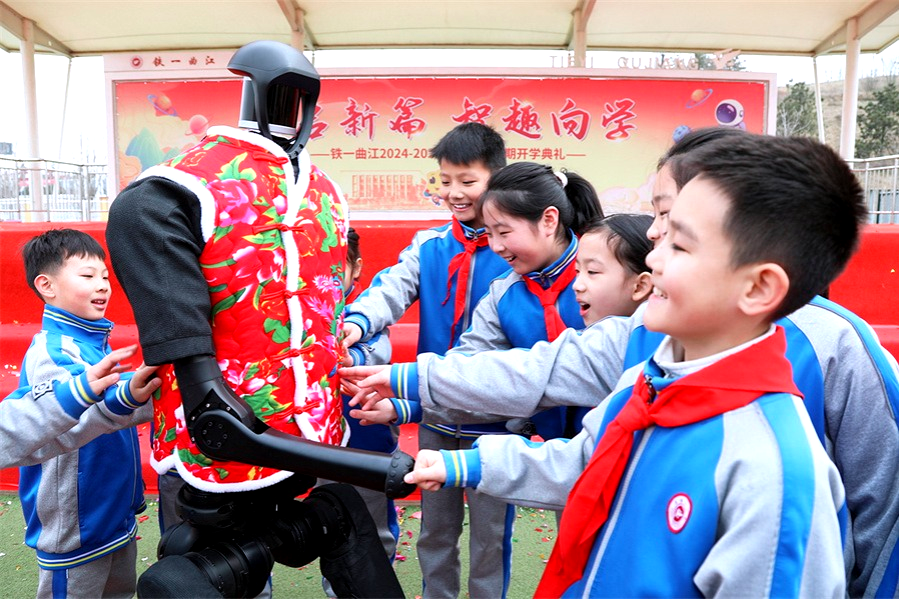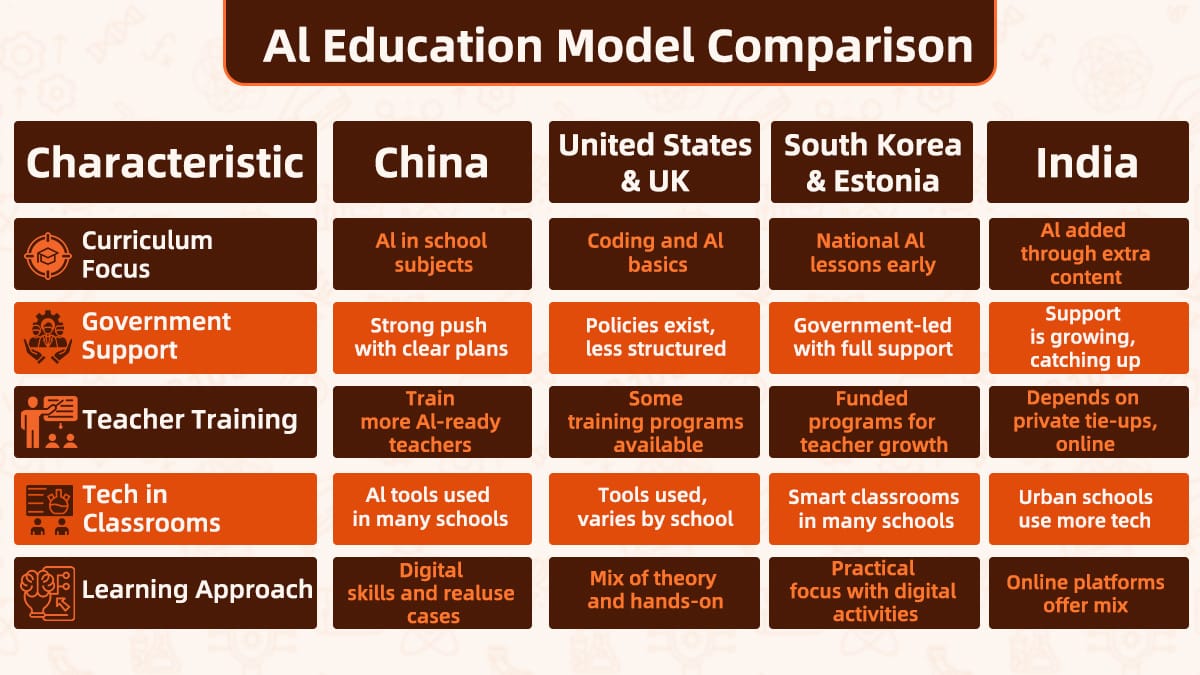China is leading the AI revolution in education, focusing on K-12 international schools to prepare students for a tech-driven future. The Chinese government believes that integrating artificial intelligence into education will equip students with essential skills. The mission of China's AI leadership in education is to create a generation of technologically savvy learners who are ready to compete globally.

The vision includes a dynamic educational system where AI helps students develop critical thinking and problem-solving abilities. By fostering such skills, China aims to position its students at the forefront of global innovation and drive technological innovation that contributes to the Chinese economy.
Chinese institutions, including secondary schools, are adopting cutting-edge AI models to personalize learning and improve outcomes. This article explores how China's K-12 international schools are leading this charge and setting new standards in AI education worldwide.
Introduction to the AI Revolution in China’s Education
Artificial intelligence is changing how we learn. It's no longer just in movies. Now, AI is a big part of education. The Ministry of Education is pushing schools to use AI. They've got a plan to make this happen. It's all about improving learning with smart tools.
Schools in Shanghai are leading the way. They're already using AI to teach students in new and exciting ways. This change isn't just about using AI. It's about making sure students are ready for the future.
AI plays a crucial role. It helps create better learning paths. With AI, students get a more holistic learning experience. They can explore different learning styles. This means they learn in ways that suit them best.
Digital innovations in education are also key. These innovations make learning fun and engaging. The education industry is changing fast. AI is part of these educational reforms. It's all about boosting technological literacy among students.
In the end, AI in schools is about growth. It's about preparing students for an AI-driven world. Shanghai is setting the standard. Other places can learn a lot from their approach. The future of education looks bright, with AI leading the way.
Alifa Education Services bridges ed-tech entrepreneurs and policymakers with China's leading AI companies. Get matched with the perfect technology partner for your region.
Book Your Partnership Consultation Today!
Tell us your needs—we'll find your ideal Chinese AI firm match
Why China Is Emerging as a Global AI Education Leader
China is leading the way in AI education. Its focus on advanced technologies and effective implementation is a game changer.
Strategic Government Policies Driving AI Integration
China's government is pushing for AI in education. They’re creating policies that support advanced technologies and effective implementation.
These policies provide growth opportunities and educational opportunities for students. Focusing on improved efficiency, they’re improving the educational process. This is truly a game-changer.
Shanghai's International Schools at the Forefront
Shanghai's international schools are leading in AI education. They're using advanced technologies to create unique educational opportunities. These schools focus on the educational process, making learning engaging and effective.
By adopting new implementation strategies, they’re preparing a generation of students for a tech-driven future.
Want to put your brand in front of families, students, and education-focused readers? We're inviting select partners to advertise with us on our trusted blog.
Want to get featured? Click 'Learn more' and submit a story for us to include.
Robust Infrastructure and Technological Investments
China invests heavily in AI infrastructure. This includes advanced technologies and innovative educational tools. These investments are a game changer for the educational process.
They offer growth opportunities and improve efficiency. Such efforts ensure that students have access to the best educational opportunities available.
Cultivating Future-Ready, AI-Literate Students
China focuses on creating a generation of students ready for the future. They’re using AI to teach skills needed for tomorrow.
The educational process is adapting with implementation strategies that focus on improved efficiency. This approach offers students the educational opportunities they need to succeed.
Pioneering Curriculum and Teaching Innovations
China is changing how students learn. It is introducing new curricula that incorporate advanced technologies. These innovations provide educational opportunities that prepare students for the future.
With a focus on effective implementation and improved efficiency, China’s education system is truly a game changer for the world.
Challenges and Ethical Concerns in AI-Based Education
AI is transforming education, yet challenges and ethical concerns persist. Effective implementation in Chinese education requires careful consideration and adaptation.
Teacher Preparedness
Teachers need training to handle artificial intelligence in classrooms. Effective implementation is key, but many educators lack the skills. The education sector must support teachers in mastering these new tools.
Resource Distribution
A big challenge is the gap between schools. Urban schools have advanced tools, while many rural ones struggle. Chinese education must focus on equal resource distribution to improve educational practice for all.
Ethical Concerns
Using artificial intelligence in education raises ethical questions. Privacy and responsible use are major worries. The education sector should guide students on these issues, ensuring ethical educational practice.
Curriculum Adaptability
AI evolves quickly, and so should curricula. Keeping lessons current is vital for effective implementation. The Chinese education system must adapt its educational practices to meet this challenge.
Comparing China’s AI Education Model with the West
Here is a comparison between China’s AI education model and the West.

Shanghai’s Top 8 High School’s AI Companion Program
So, which 8 High Schools in Shanghai are giving AI leadership in China’s education? Here is the list,
Dulwich Pudong: The Magic of AI in Reading Class
AI-powered classroom technologies help young students read better. The program boosts focus, adapts to learning characteristics, and adds fun to Chinese education’s teaching-learning process.
- Students read faster with real-time AI support
- Each child gets help based on their learning characteristics
- Lessons become fun, not boring, improving the teaching-learning process
Yew Chung International: AI Powers Creativity
The school blends future AI technologies with real-world projects. Students use AI tools to explore, invent, and grow their skills through hands-on educational practice.
- Kids explore future AI technologies through real projects
- AI boosts creative thinking and sharpens tech skills
- Tasks become smoother, improving operational efficiency in class
Harrow Shanghai: A Fantastical Learning Journey with VR + AI
AI and VR build an exciting learning space. From science labs to after-school clubs, students dive into future tech, boosting engagement across the education sector.
- Students enjoy interactive AI-based learning sessions
- VR and AI make complex ideas easy to grasp
- School brings fun and depth into the education sector
Nord Anglia: Deep Dive into Robotics and AI
The program mixes robotics and AI-powered classroom technologies. Students start with basic parts and grow into builders, mastering operational efficiency and future AI technologies.
- Students learn how AI powers robot intelligence
- Projects boost problem-solving and creative thinking
- Hands-on work teaches how machines and people connect
Shangde: A Comprehensive AI Curriculum
Shangde offers AI for all ages. Their learning path, which involves drones, games, and high-level coding, blends curiosity and structure in modern educational practice.
- Young learners enjoy AI games and drone projects
- Older kids move into advanced AI applications
- The full program supports long-term educational practice
Liaoyuan Bilingual: Merging AI with Subjects
AI connects subjects like maths and science into one smart system. Students think across topics, strengthening the teaching-learning process in Chinese education.
- Students link AI with maths, science, and language
- Teaching-learning process becomes more creative and fun
- AI makes classroom work smarter with better feedback
Hongwen School: SocraticBot—An AI Learning Partner
SocraticBot changes how students think and ask questions. It supports active learning, builds curiosity, and adds depth to classroom lessons in the education sector.
- Kids ask questions and learn through guided chat
- Bot encourages deep thinking and problem-solving
- Parents stay involved in the learning journey, too
Qibao Dwight High School
Students use AI tools for lab simulations and contests. The school combines theory with real experience, boosting confidence and creativity through future AI technologies.
- Physics labs use AI simulations for safe experiments
- Students join AI events to sharpen their creativity
- The school blends future AI technologies with real practice
Conclusion
China’s AI revolution in education sets a benchmark with its innovative K-12 international schools. Their use of AI tools for personalized learning is reshaping global standards.
Many educational institutions and academic institutions across the country are adopting adaptive learning systems and advanced language models to enhance teaching and learning experiences.
The Chinese government supports these initiatives to provide a competitive edge for middle school and international students.
China's AI leadership in education vision integrates AI with curriculum reforms. This vision also includes nurturing emotional intelligence alongside technical skills, ensuring a well-rounded development for learners.
Will the world follow China’s pace or let it redefine future-ready education?
Ready to take the next step in your child’s education journey? Alifa Educational Services helps you discover top junior and secondary schools in China. We help families every step of the way. We handle school selection, visa support, and ongoing care. This makes the process easy and stress-free. Let’s give your child the best start—contact us today!
Related Articles












Member comments